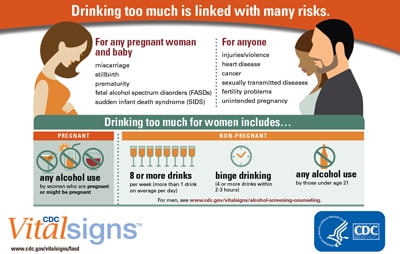Sexually active women who stop using birth control should stop drinking alcohol, but most keep drinking
 Drinking too much can have many risks for women. Entire Infographic
Drinking too much can have many risks for women. Entire Infographic
Atlanta, GA–(ENEWSPF)–February 2, 2016. An estimated 3.3 million women between the ages of 15 and 44 years are at risk of exposing their developing baby to alcohol because they are drinking, sexually active, and not using birth control to prevent pregnancy, according to the latest CDC Vital Signs report released today. The report also found that 3 in 4 women who want to get pregnant as soon as possible do not stop drinking alcohol when they stop using birth control.
Alcohol use during pregnancy, even within the first few weeks and before a woman knows she is pregnant, can cause lasting physical, behavioral, and intellectual disabilities that can last for a child’s lifetime. These disabilities are known as fetal alcohol spectrum disorders (FASDs). There is no known safe amount of alcohol – even beer or wine – that is safe for a woman to drink at any stage of pregnancy.
“Alcohol can permanently harm a developing baby before a woman knows she is pregnant,” said CDC Principal Deputy Director Anne Schuchat, M.D. “About half of all pregnancies in the United States are unplanned, and even if planned, most women won’t know they are pregnant for the first month or so, when they might still be drinking. The risk is real. Why take the chance?”
Healthcare providers should advise women who want to become pregnant to stop drinking alcohol as soon as they stop using birth control. Most women don’t know they are pregnant until they are four to six weeks into the pregnancy and could unknowingly be exposing their developing baby to alcohol. FASDs are completely preventable if a woman does not drink alcohol during pregnancy.
For this Vital Signs report, scientists from CDC’s National Center on Birth Defects and Developmental Disabilities analyzed data from the 2011–2013 National Survey of Family Growth, which gathers information on family life, marriage, divorce, pregnancy, infertility, use of birth control, and men’s and women’s health. National estimates of alcohol-exposed pregnancy were calculated among 4,303 non-pregnant, non-sterile women ages 15–44 years. A woman was considered to be at risk for an alcohol-exposed pregnancy if in the past month she was not sterile, her partner was not known to be sterile, she had vaginal sex with a male, drank any alcohol, and did not use birth control. A woman was considered to be trying to get pregnant if a desired pregnancy was the reason she and her partner stopped using contraception.
Overall, 3.3 million US women (7.3 percent of women ages 15–44 who were having sex, who were non-pregnant and non-sterile) were at risk of exposing their developing baby to alcohol if they were to become pregnant.
“Every woman who is pregnant or trying to get pregnant – and her partner – want a healthy baby. But they may not be aware that drinking any alcohol at any stage of pregnancy can cause a range of disabilities for their child,” said Coleen Boyle, Ph.D., director of CDC’s National Center on Birth Defects and Developmental Disabilities. “It is critical for healthcare providers to assess a woman’s drinking habits during routine medical visits; advise her not to drink at all if she is pregnant, trying to get pregnant or sexually active and not using birth control; and recommend services if she needs help to stop drinking.”
CDC works to prevent alcohol-exposed pregnancies and FASDs through a variety of activities including:
- Tracking alcohol use among women of reproductive age in the United States;
- Supporting the implementation of evidence-based interventions to reduce risky alcohol use and alcohol-exposed pregnancies, including through alcohol screening and brief intervention and the CHOICES program;
- Collaborating with FASD Practice and Implementation Centers and national partners to promote practice changes among healthcare providers in the prevention, identification, and management of FASDs;
- Promoting effective interventions for children, adolescents, and young adults living with FASDs and their families; and
- Offering FASD-related educational information and materials for women of reproductive age, healthcare providers, and the general public.
For more information about alcohol use during pregnancy and FASDs, please visit www.cdc.gov/fasd.
Vital Signs is a CDC report that appears on the first Tuesday of the month as part of the CDC journal Morbidity and Mortality Weekly Report. The report provides the latest data and information on key health indicators. These are cancer prevention, obesity, tobacco use, motor vehicle passenger safety, prescription drug overdose, HIV/AIDS, alcohol use, health care-associated infections, cardiovascular health, teen pregnancy, food safety and viral hepatitis
Source: http://www.cdc.gov








